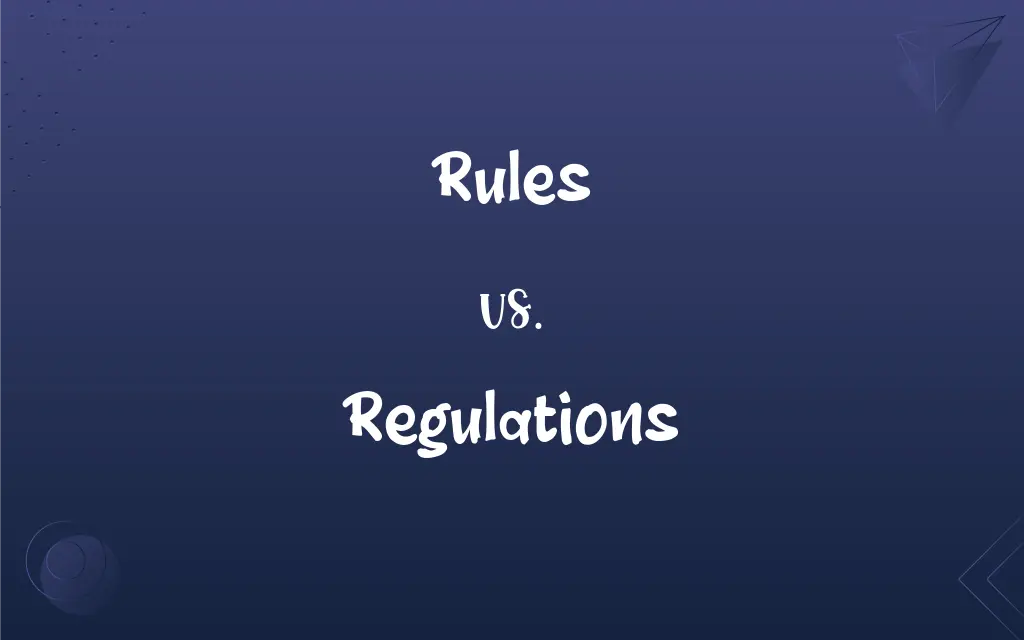Rules vs. Regulations: What's the Difference?
Edited by Janet White || By Harlon Moss || Updated on October 9, 2023
Rules are general guidelines set to govern behavior within an organization, while regulations are specific guidelines or statutes passed by government bodies to manage conduct on a broader scale.

Key Differences
The term "rules" generally connotes internally set guidelines meant to steer conduct within a specific entity or group. Rules might be created by individuals, such as parents or teachers, or organizations, to establish a normative code of behavior. In contrast, "regulations" often refer to a set of directives imposed by authority, ensuring uniformity in adherence to laws within a broader community or nation.
Diving into rules, one might observe that they can sometimes be informal, and may be developed over time through societal or organizational norms. On the other hand, regulations are specifically formulated, documented, and enforced by a pertinent authority, usually a governmental body. The enforcement of regulations tends to carry legal weight and can be supported by penal provisions.
In a more narrowed context, rules may sometimes be more flexible, allowing for occasional deviations if the situation permits. Contrarily, regulations, given their legal standing, allow for little to no flexibility and necessitate stringent adherence. Regulations, due to their more formal stature, must be followed to avoid legal consequences.
In the context of organizations or smaller entities, rules serve to guide members and establish a harmonious internal environment. Whereas regulations serve to ensure that the conduct of citizens or entities adheres to a structured format which aligns with the broader legislative framework of a nation or community.
Comparison Chart
Definition
General guidelines set by an entity
Legal directives set by an authority
ADVERTISEMENT
Authority
Can be non-governmental
Governmental bodies
Flexibility
Can be flexible
Strict and less flexible
Scope
Generally within an organization
Wide-reaching, at regional or national levels
Legal Consequence
May not have legal penalties
Has legal penalties
Rules and Regulations Definitions
Rules
A piece of advice or guideline.
The rules for good health include balanced diet and exercise.
ADVERTISEMENT
Regulations
The act of regulating or state of being regulated.
The regulations of utilities is crucial for consistent service provision.
Rules
A regulation or principle governing conduct.
The rules were implemented to ensure orderly conduct.
Regulations
A law or directive made and maintained by an authority.
Environmental regulations ensure the preservation of natural resources.
Rules
General guidelines or principles.
The rules of the game are simple and easy to follow.
Regulations
A rule or directive made and maintained by an authority.
The company must adhere to government regulations.
Rules
A statement that describes what will always happen in a particular situation.
The rules of physics explain the phenomena around us.
Regulations
A rule for action of conduct.
Industry regulations protect consumers from potential hazards.
Rules
Prescribed directives for work or play.
Please read the rules before starting the exam.
Regulations
Official instructions or principles.
Regulations require the submission of certain documents.
FAQs
What defines a rule?
A rule is a set guideline, often informal, which dictates the expected behavior within a particular system or organization.
Is following rules mandatory?
Following rules is generally expected, but adherence might not carry legal implications unless linked to established laws.
Who typically sets rules?
Rules can be set by any entity, individual, or group such as parents, teachers, or organizational leaders.
Can rules evolve over time?
Yes, rules can evolve and adapt over time based on the changing needs and dynamics of a group or organization.
What is a regulation?
A regulation is a specific rule or directive created and enforced by an authority, usually a government, to manage conduct on a wide scale.
Can a rule have legal standing?
Generally, rules might not have legal standing unless they are formally codified into law or linked to existing legal frameworks.
Can rules vary within an organization?
Yes, rules can be modified or vary within different departments or sections of an organization based on specific needs.
Can rules apply to a wide range of scenarios?
Yes, rules can be general and apply to various situations, although they may not have widespread legal backing.
How are individuals made aware of regulations?
Regulations are usually made available through official gazettes, websites, public notices, or other formal communication channels to ensure widespread awareness.
Are regulations always related to laws?
Yes, regulations are usually linked with laws and carry legal consequences if not adhered to.
Can regulations be modified easily?
Regulations typically involve a more structured and formal process for modifications, often involving legal processes or legislative actions.
Do regulations focus on specific issues or sectors?
Yes, regulations often address specific issues, sectors, or actions and are crafted to manage them specifically.
Are rules formalized or written?
Rules can be both formalized/written or informally communicated and adhered to within a group or entity.
Are regulations always written and documented?
Yes, regulations are formally documented to ensure clear communication and understanding of the directives by all applicable parties.
Who is responsible for creating regulations?
Regulations are typically created by governmental bodies or authorities with the jurisdiction to enforce adherence to them.
Can rules be created by anyone?
Theoretically, yes. Anyone with authority in a specific context, like a teacher or a manager, can create rules pertinent to their domain.
Who ensures the enforcement of regulations?
Regulations are enforced by the relevant authoritative bodies, such as governmental agencies or regulatory authorities.
How are regulations adapted to societal changes?
Regulations adapt through legislative amendments or the creation of new regulations to address emerging issues or societal shifts.
Can rules and regulations overlap?
While distinct, rules and regulations can overlap, especially if rules are formulated in alignment with existing regulations.
What happens if regulations are not followed?
Non-compliance with regulations often results in legal consequences, such as fines, penalties, or other lawful actions.
About Author
Written by
Harlon MossHarlon is a seasoned quality moderator and accomplished content writer for Difference Wiki. An alumnus of the prestigious University of California, he earned his degree in Computer Science. Leveraging his academic background, Harlon brings a meticulous and informed perspective to his work, ensuring content accuracy and excellence.
Edited by
Janet WhiteJanet White has been an esteemed writer and blogger for Difference Wiki. Holding a Master's degree in Science and Medical Journalism from the prestigious Boston University, she has consistently demonstrated her expertise and passion for her field. When she's not immersed in her work, Janet relishes her time exercising, delving into a good book, and cherishing moments with friends and family.
































































